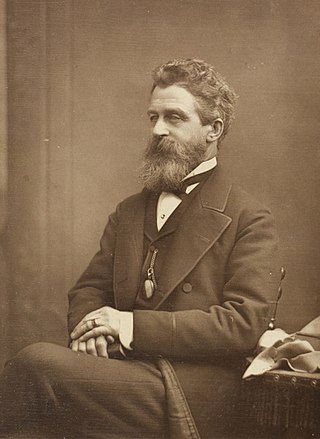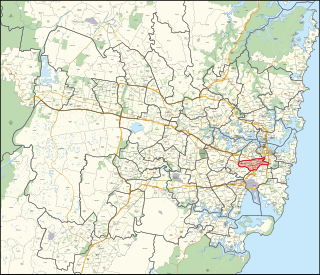
Marrickville was an electoral district of the Legislative Assembly in the Australian state of New South Wales. It was an urban electorate in Sydney's inner west, centred on the suburb of Marrickville from which it took its name. At the time of its abolition it also included the suburbs of Camperdown, Darlington, Enmore, Lewisham, Newtown, Petersham, Stanmore and parts of Dulwich Hill and Erskineville as well as the University of Sydney.

Sir Daniel Cooper, 1st Baronet was a nineteenth-century politician, merchant and philanthropist in the Colony of New South Wales. He served as the first speaker of the Legislative Assembly of the colony and was a noted philatelist.

Sydney is an electoral district of the Legislative Assembly of the Australian state of New South Wales in Inner Sydney. It includes the Sydney CBD; the suburbs and localities of Barangaroo, Broadway, Chinatown, Darling Harbour, Darlinghurst, Dawes Point, Elizabeth Bay, Haymarket, Millers Point, Paddington, Potts Point, Pyrmont, The Rocks, Woolloomooloo, Wynyard, Surry Hills, Rushcutters Bay; and parts of Ultimo.

Balmain is an electoral district of the Legislative Assembly of the Australian state of New South Wales in Sydney's Inner West. It is currently represented by Kobi Shetty of the Greens New South Wales.
Cumberland (North Riding) was an electoral district of the Legislative Assembly in the Australian state of New South Wales from 1856 to 1859, in Cumberland County, which includes Sydney. It included all of the county north of Parramatta Road and the Great Western Highway, except for the urban electorates of Sydney (City), Sydney Hamlets, Parramatta and Cumberland Boroughs, which included Richmond and Windsor. It elected two members simultaneously, with voters casting two votes and the first two candidates being elected. It was abolished in 1859 and the district was divided between Central Cumberland, Windsor, Nepean and St Leonards.
Cumberland (South Riding) was an electoral district of the Legislative Assembly in the Australian state of New South Wales from 1856 to 1859, in the rural part of Cumberland County, which includes Sydney. It included all of the county south of Parramatta Road and the Great Western Highway, except for the urban electorates of Sydney (City), Sydney Hamlets, Parramatta and Cumberland Boroughs, which included Liverpool and Campbelltown. It elected two members simultaneously, with voters casting two votes and the first two candidates being elected.
East Sydney was an electoral district for the Legislative Assembly, in the Australian colony of New South Wales created in 1859 from part of the Electoral district of Sydney City, covering the eastern part of the current Sydney central business district, Woolloomooloo, Potts Point, Elizabeth Bay and Darlinghurst, bordered by George Street to the east, Boundary Street to the west, and, from the creation of South Sydney in 1880, Liverpool Street and Oxford Street, to the south. It elected four members simultaneously, with voters casting four votes and the first four candidates being elected. For the 1894 election, it was replaced by the single-member electorates of Sydney-King, Sydney-Fitzroy and Sydney-Bligh.
West Sydney was an electoral district for the Legislative Assembly in the Australian State of New South Wales created in 1859 from part of the electoral district of Sydney, covering the western part of the current Sydney central business district, Ultimo and Pyrmont, bordered by George Street, Broadway, Bay Street and Wentworth Park. It elected four members simultaneously, with voters casting four votes and the first four candidates being elected. For the 1894 election, it was replaced by the single-member electorates of Sydney-Gipps, Sydney-Lang, Sydney-Denison and Sydney-Pyrmont.
Redfern was an electoral district of the Legislative Assembly in the Australian state of New South Wales, created in 1880, and named after and including the Sydney suburb of Redfern. It extended to Botany Bay and was bordered by Rainbow Street (Redfern), Anzac Parade, the southern edge of Moore Park, South Dowling Street, Cleveland Street, City Road, King Street, Newtown, Alexandra Canal and Cooks River. It elected two members from 1880 to 1882, three members from 1882 to 1887 and four members from 1887 until the abolition of multi-member electorates in 1894, when it was split into Redfern, Botany, Darlington, Waterloo and part of Newtown-Erskine. In 1920, with the introduction of proportional representation, it was absorbed into Botany. It was recreated in 1927 and abolished in 1968.

Newtown is an electoral district of the Legislative Assembly in the Australian state of New South Wales. It includes the inner Sydney suburbs of Redfern, Chippendale, Darlington, Eveleigh, Newtown, Enmore, Stanmore and Petersham and parts of Waterloo, Erskineville, Camperdown, Marrickville and Lewisham. It is held by Jenny Leong of the Greens.
Paddington was an electoral district of the Legislative Assembly in the Australian state of New South Wales, originally created in 1859, partly replacing Sydney Hamlets. It included the suburbs of Paddington and Redfern. The rest of Sydney's current Eastern Suburbs, which were then rural, were part of Canterbury. With the creation of the electoral districts of South Sydney and Redfern in 1880, Paddington included the northern part of the eastern suburbs, generally east of what is now known as Anzac Parade and north of Rainbow Street, including all of current Woollahra and Waverley and part of Randwick. It elected one member from 1859 to 1880, two members from 1880 to 1885, three members from 1885 to 1889 and four members from 1889 to 1894. With the abolition of multi-member constituencies in 1894, it was replaced by the single-member electorates of Paddington, Waverley, Woollahra and Randwick. In 1920, with the introduction of proportional representation, it was absorbed into Sydney. Paddington was recreated in 1927. In 1959, it was combined with part of Waverley and renamed Paddington-Waverley, which was itself abolished in 1962 and partly replaced by Bligh.
St Leonards was an electoral district of the Legislative Assembly in the Australian state of New South Wales, created in 1859, partly replacing Sydney Hamlets, and named after the Sydney suburb of St Leonards, which then included North Sydney, its main settlement. It extended from North Sydney to Broken Bay, including the Northern Beaches. It elected one member from 1859 to 1882, two members from 1882 to 1889 and three members from 1889 to 1894. With the abolition of multi-member constituencies in 1894, it was replaced by the single-member electorates of St Leonards, Warringah and Willoughby. In 1920, with the introduction of proportional representation, it was absorbed into North Shore.
Glebe or The Glebe was an electoral district of the Legislative Assembly in the Australian state of New South Wales, originally created in 1859, partly replacing Sydney Hamlets, and named after and including the Sydney suburb of Glebe. It elected one member from 1859 to 1885 and two members from 1885 to 1894. In 1920, with the introduction of proportional representation, it was absorbed into Balmain. Glebe was recreated in 1927 and abolished in 1941.
Randwick was an Australian electoral district of the Legislative Assembly in the Australian state of New South Wales, originally created with the abolition of multi-member constituencies in 1894 from part of Paddington, along with Waverley and Woollahra. It was named after and including the Sydney suburb of Randwick. In 1920, with the introduction of proportional representation, it was absorbed into Eastern Suburbs. Randwick was recreated in 1927 and abolished in 1971 and partly replaced by Waverley.
Camperdown was an electoral district of the Legislative Assembly in the Australian state of New South Wales, created in the 1904 re-distribution of electorates following the 1903 New South Wales referendum, which required the number of members of the Legislative Assembly to be reduced from 125 to 90. It consisted of parts of Annandale and the abolished seats of Darlington, Newtown-Camperdown and Newtown-Erskine. It was named after and included the inner Sydney suburb of Camperdown. In 1920, with the introduction of proportional representation, it was absorbed into the multi-member electorate of Balmain.
The Electoral district of Sydney Hamlets was an electorate of the New South Wales Legislative Council at a time when some of its members were elected and the balance were appointed by the Governor. It was a new electorate created in 1851 by the expansion of the Legislative Council to 54 members, with 18 to be appointed and 36 elected. The electoral district included what were then outer suburbs of Sydney and are now the inner suburbs of Glebe, Camperdown, O'Connell Town, Chippendale, Redfern, Surry Hills, Paddington, St Leonards and Balmain.
Newtown, an electoral district of the Legislative Assembly in the Australian state of New South Wales, has had four incarnations, the first from 1859 to 1894, the second from 1904 until 1920, the third from 1927 until 1950 and the fourth from 2015 until the present.
Cumberland South Riding, an electoral district of the Legislative Assembly in the Australian state of New South Wales was created in 1856 and abolished in 1859.
Sydney Hamlets, an electoral district of the Legislative Assembly in the Australian state of New South Wales, had two incarnations, from 1950 until 1971 and from 1988 until 1999.
The 1904 New South Wales state election involved 90 electoral districts returning one member each. The election was conducted on the basis of a simple majority or first-past-the-post voting system. There were two significant changes from the 1901 election, the first was that women were given the right to vote, which saw an increase in the number of enrolled voters from 345,500 in 1901, to 689,490 in 1904. The second was that as a result of the 1903 New South Wales referendum, the number of members of the Legislative Assembly was reduced from 125 to 90. The combined effect of the changes meant that the average number of enrolled voters per electorate went from 2,764, to 7,661, an increase of 277%. Leichhardt was the only district that was not substantially changed, while The Macquarie and The Murray districts retained nothing but the name.





